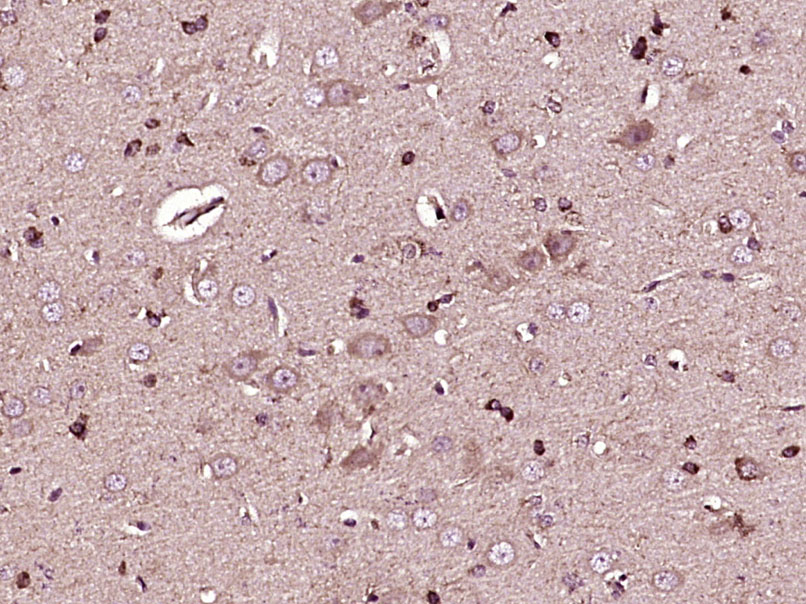
Rabbit Anti-STIM1 antibody
GOK; SIM; STIM 1; STIM-1; Stim1 stromal interaction molecule 1; STIM1_HUMAN; STIM1L; Stromal interaction molecule 1.
View History [Clear]
Details
Product Name STIM1 Chinese Name 基质交感分子1抗体 Alias GOK; SIM; STIM 1; STIM-1; Stim1 stromal interaction molecule 1; STIM1_HUMAN; STIM1L; Stromal interaction molecule 1. Research Area Tumour Cell biology Signal transduction Channel protein Cell Surface Molecule lymphocyte t-lymphocyte Immunogen Species Rabbit Clonality Polyclonal React Species Rat, (predicted: Human, Mouse, Chicken, Dog, Pig, Cow, Horse, Rabbit, ) Applications ELISA=1:5000-10000 IHC-P=1:100-500 IHC-F=1:100-500 IF=1:50-200 (Paraffin sections need antigen repair)
not yet tested in other applications.
optimal dilutions/concentrations should be determined by the end user.Theoretical molecular weight 75kDa Cellular localization cytoplasmic The cell membrane Form Liquid Concentration 1mg/ml immunogen KLH conjugated synthetic peptide derived from human STIM1: 85-180/685 <Extracellular> Lsotype IgG Purification affinity purified by Protein A Buffer Solution 0.01M TBS(pH7.4) with 1% BSA, 0.03% Proclin300 and 50% Glycerol. Storage Shipped at 4℃. Store at -20 °C for one year. Avoid repeated freeze/thaw cycles. Attention This product as supplied is intended for research use only, not for use in human, therapeutic or diagnostic applications. PubMed PubMed Product Detail Plays a role in mediating Ca(2+) influx following depletion of intracellular Ca(2+) stores. Acts as Ca(2+) sensor in the endoplasmic reticulum via its EF-hand domain. Upon Ca(2+) depletion, translocates from the endoplasmic reticulum to the plasma membrane where it activates the Ca(2+) release-activated Ca(2+) (CRAC) channel subunit, TMEM142A/ORAI1.
Function:
Plays a role in mediating store-operated Ca(2+) entry (SOCE), a Ca(2+) influx following depletion of intracellular Ca(2+) stores. Acts as Ca(2+) sensor in the endoplasmic reticulum via its EF-hand domain. Upon Ca(2+) depletion, translocates from the endoplasmic reticulum to the plasma membrane where it activates the Ca(2+) release-activated Ca(2+) (CRAC) channel subunit, TMEM142A/ORAI1.
Subunit:
Forms homooligomers and heterooligomers with STIM2. Interacts with ORAI1. Interacts with MAPRE1; probably required for targeting to the growing microtubule plus ends. Interacts with EFCAB4B/CRACR2A; the interaction is direct and takes place in absence of Ca(2+). Forms a complex with EFCAB4B/CRACR2A and ORAI1 at low concentration of Ca(2+), the complex dissociates at elevated Ca(2+) concentrations. Interacts with TMEM66/SARAF, promoting a slow inactivation of STIM1-dependent SOCE activity, possibly by facilitating the deoligomerization of STIM1.
Subcellular Location:
Cell membrane. Endoplasmic reticulum membrane. Cytoplasm > cytoskeleton. Translocates from the endoplasmic reticulum to the cell membrane in response to a depletion of intracellular calcium. Associated with the microtubule network at the growing distal tip of microtubules.
Tissue Specificity:
Ubiquitously expressed in various human primary cells and tumor cell lines.
Post-translational modifications:
Glycosylation is required for cell surface expression.
Phosphorylated predominantly on Ser residues.
DISEASE:
Defects in STIM1 are the cause of immune dysfunction with T-cell inactivation due to calcium entry defect type 2 (IDTICED2) [MIM:612783]. IDTICED2 is an immune disorder characterized by recurrent infections, impaired T-cell activation and proliferative response, decreased T-cell production of cytokines, lymphadenopathy, and normal lymphocytes counts and serum immunoglobulin levels. Additional features include thrombocytopenia, autoimmune hemolytic anemia, non-progressive myopathy, partial iris hypoplasia, hepatosplenomegaly and defective enamel dentition.
Similarity:
Contains 1 EF-hand domain.
Contains 1 SAM (sterile alpha motif) domain.
SWISS:
Q13586
Gene ID:
6786
Database links:
Entrez Gene: 6786 Human
Entrez Gene: 20866 Mouse
Omim: 605921 Human
SwissProt: Q13586 Human
SwissProt: P70302 Mouse
Unigene: 501735 Human
Unigene: 645 Mouse
Unigene: 106771 Rat
Product Picture
References (0)
No References
Bought notes(bought amounts latest0)
No one bought this product
User Comment(Total0User Comment Num)
- No comment



 +86 571 56623320
+86 571 56623320
 +86 18668110335
+86 18668110335

